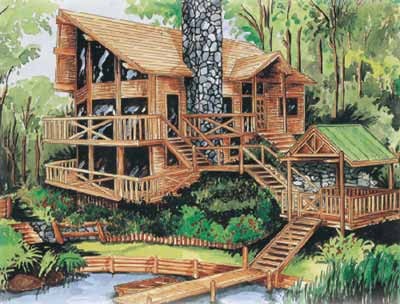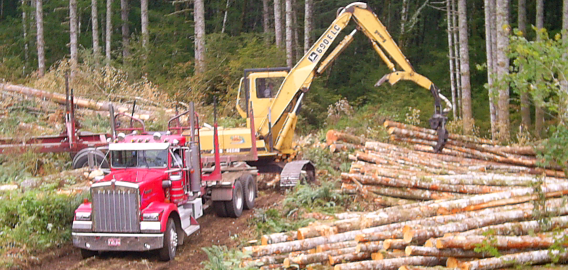For Some Sound of Profit Is Timber!
Post on: 18 Июль, 2015 No Comment

While Other Investments Wither, Forest Land’s Value Keeps Growing
ENLARGE
Through Sept. 30, the value of timberland rose 5%. When the National Council of Real Estate Investment Fiduciaries reports 2008’s final quarter this week, this number is unlikely to move much. That marks a slower pace of growth, yet it is growth nonetheless. In 2007, timber appreciation was a towering 15%.
How can positive returns exist in these dark days of shrunken prices for everything ranging from real estate to commodities to stocks? Oil, after a summer price spike, was down 54% in 2008, while corn lost 11% and copper 54%. (Gold, as a refuge commodity, rose 6%.) Prices for lumber, a key forest product, have fallen by 34% over the past year as housing construction has ebbed.
The answer to this riddle is that timberland is the ultimate long-term investment, with relatively little bought and sold each year — and demand still respectable for what does change hands. As long as the sun shines, the trees will grow, says Jeremy Grantham, chairman of Boston money manager GMO and a long-time fan of timber investing. Timber will never be an orphan.
Timber often is likened to high-grade bonds, meant to be held for 10 years or more. The average annual timberland appreciation for the past decade is 4.1% versus minus 3.8% for the Standard & Poor’s-500 stock index. The timberland appreciation figure, which encompasses both the land and the trees, is based on sales and appraisals. After 10 or 15 years, investors cash out when the land is sold.
On top of the appreciation, timber generates regular income. Trees are constantly chopped down and sold for everything from boards to paper mulch, albeit in smaller volumes these days. Cash returns from this harvesting, as it’s called, are now 1.5% of the property value, down from 3% in 2007 and about 5% annually the three years before that.
ENLARGE
Forester Dag Rutherford, a senior vice-president at Bank of America’s U.S. Trust, knows timber is a long-term investment. ‘No quick pay-offs here.’ Jason Grow for The Wall Street Journal
Nobody creates investor dividends quite so dramatically as a woodsman. Standing amid 70-foot pines that thrust into the cool New England air, Dag Rutherford, a rangy veteran forester, gives the go-ahead to start the day’s cutting. These trees took decades to grow, says Mr. Rutherford, a senior vice-president at Bank of America’s U.S. Trust wealth-management unit, which runs this tract for a rich family. People still need wood.
This day’s tree toppling, in the deep woods about 100 miles from Boston, should bring up to $8,000 worth of lumber. The operation is masterfully efficient, capable of felling around 80 trees in two hours. Time was, a lumberjack with a chain saw would take a day to do that.
For this job, though, Mr. Rutherford has hired a giant machine that resembles something out of the movie Transformers. Run by one man in a cabin atop a tractor-like chassis, this $1 million harvester machine has a huge claw that grabs a trunk and swiftly severs it with an embedded saw. The tree falls noisily to earth with a bird-frightening crash. Then the tree is fed through the claw, which snips off branches and slices the trunk into 16-foot logs.
The 6-foot-4 Mr. Rutherford, born in Canada, spent his youth working on family timberlands in his ancestral Norway and has forestry in his blood. Both sides of his family tree have loggers. As he tromps through the Massachusetts boondocks, he sees a sapling. This will be a mighty oak in 75 years, he says. No quick pay-offs here.

Back in the late 1990s, when investors were obsessed with tech stocks, timberland seemed stodgy and fetched around $700 to $800 an acre, according to the Conservation Fund, a big timberland buyer. Then came the past decade’s housing boom, and big investors got interested. Wood-products giants like Weyerhaeuser Co. cashed in by divesting vast forested tracts to a welter of private partnerships, university endowments, real-estate investment trusts and other financial buyers.
Prices have since risen to the $1,500 to $3,000 range, depending on the quality of the wood.
One allure of timber is that it isn’t closely correlated with other asset classes. That’s because it is highly flexible. Other organic commodities like corn or pork have to come to market in season, or they will rot.
Trees keep growing 4% per year, no matter what happens to inflation, interest rates or market trends, says Dennis Moon, head of U.S. Trust’s group overseeing timberland, as well as farm and mineral investments. You don’t have to cut them down this year if that doesn’t make sense.
On the downside is that, as the ultimate long-term investment, timber is very illiquid. Looking to park your kid’s college tuition someplace for eight years? Forget wood. Plus, timber’s cost of entry is dauntingly high. The best returns, adjusted for risk, come from large, multimillion-dollar partnerships called timber-investment management organizations, or TIMOs, sponsored by the likes of GMO and U.S. Trust. But these require a minimum $250,000 investment, and often many times that.
TIMOs’ overhead can be onerous, too: They may charge from 3% to 5% per year in assets for property management, taxes and insurance.
A cheaper way of investing in timber is via several real-estate investment trusts. Most prominent is Plum Creek Timber Co. the largest private land holder in the U.S. Investors can get in for around $32 per share. Over the past 52 weeks, its price has fallen 26%, better than the S&P 500’s 37% drop. Indeed, Plum Creek’s showing is better than the S&P paper and forest product index, which has slid 50%. The index is focused on board-making companies like Weyerhaeuser, whose fortunes are more closely tied to the housing industry, rather than the slow-growing majesty of a maple.














